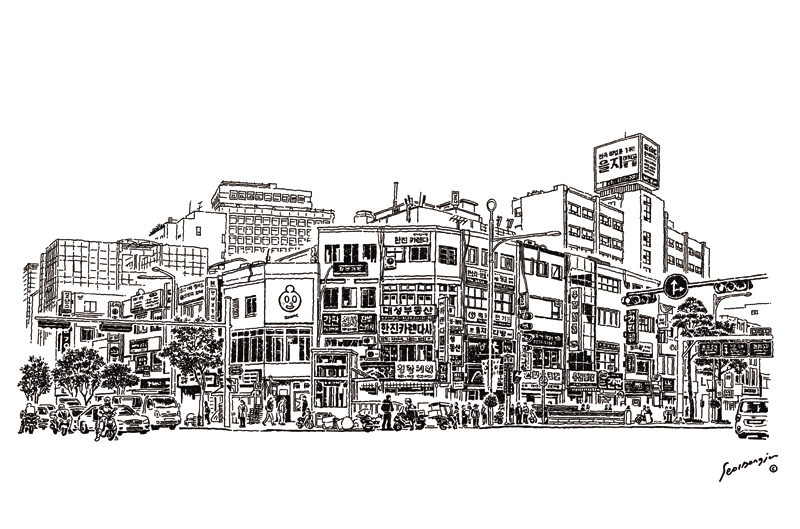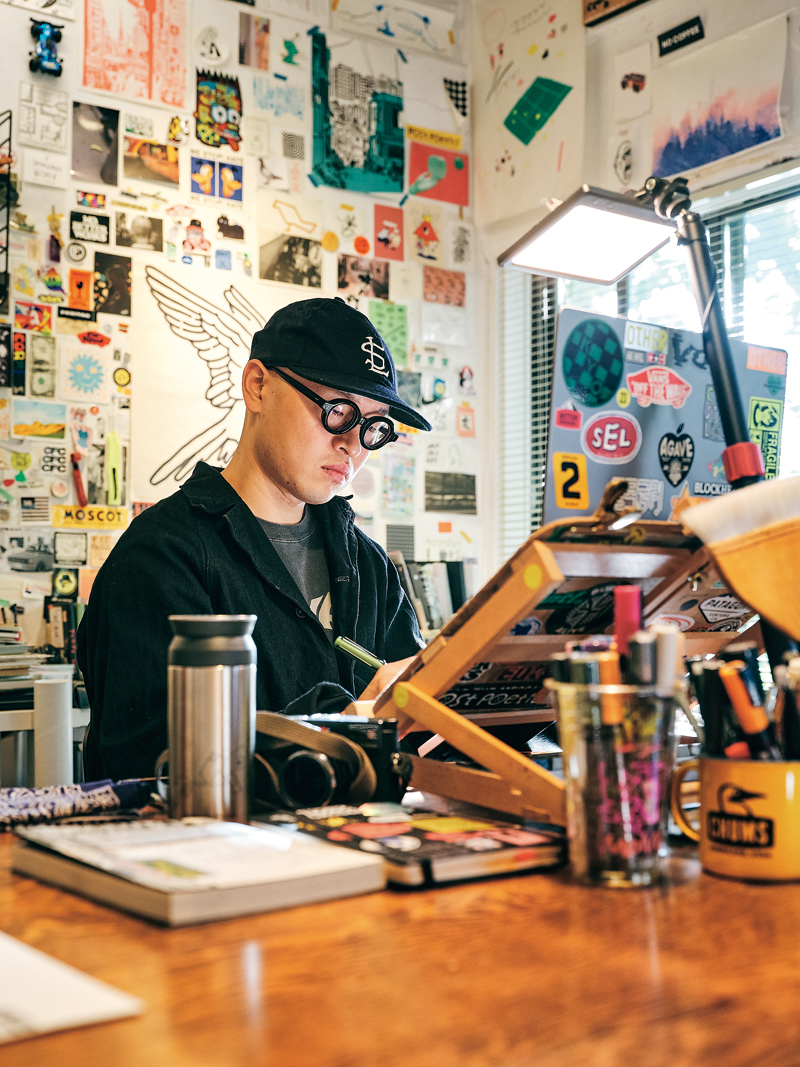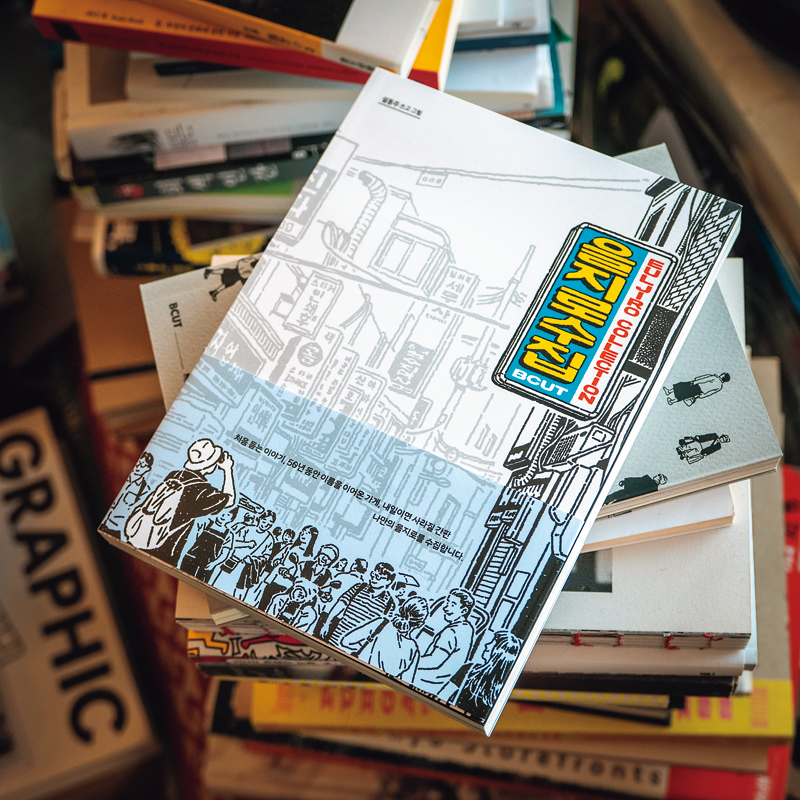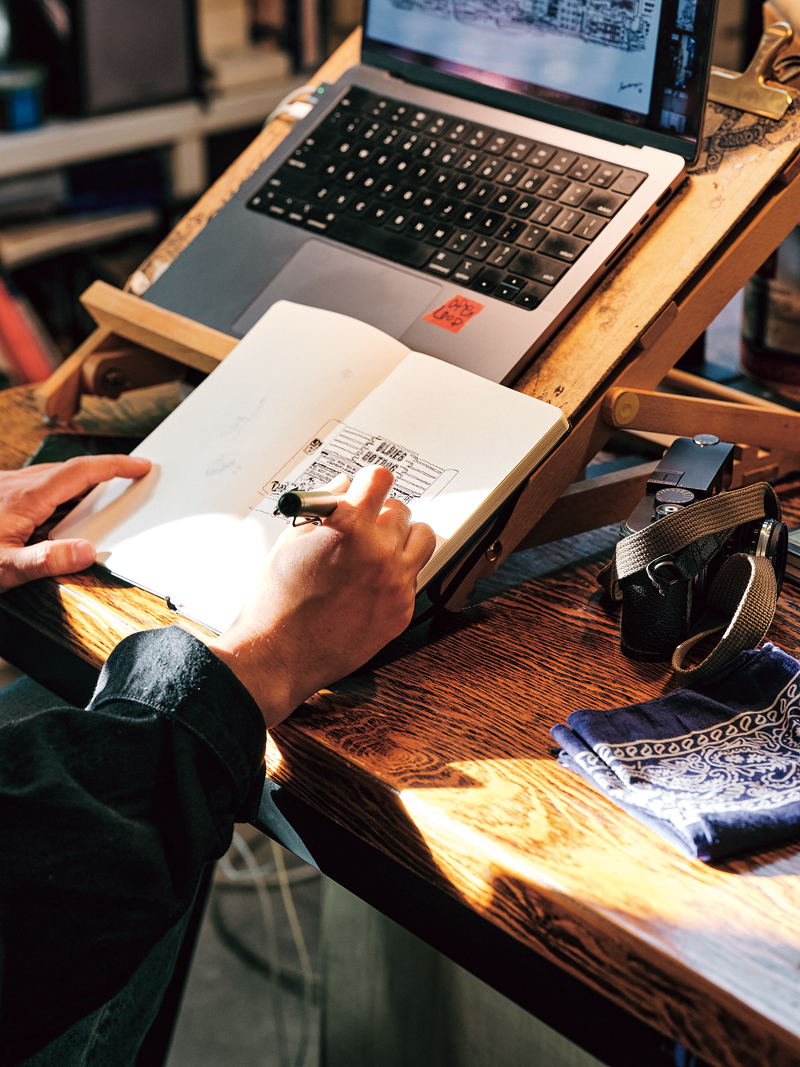Illustrator Seol Dong-ju s cities through photographs and drawings, recording people and places with endearing pen strokes. His 2020 book
Euljiro Collection depicts the eponymous neighborhood from a personal perspective that reflects his deep attachment to the area.

Euljiro 3-ga Intersection. Seol Dong-ju. 2019. Pen on paper. 39.4 × 54.5 cm.
The first thing that catches your eye when entering Seol Dong-ju’s studio near Seoul Station is a stencil design in a Gothic font. It reads “We Live City We love,” which points to the theme that defines Seol’s work: his love of cities.
“I visited Euljiro often, drawn in by the comfort that old things provide,” Seol explains. His book Euljiro Collection evokes nostalgia for bygone places and scenes before they disappear. Within is an assemblage of images and interviews with young people working to preserve Euljiro’s culture by merging old and new. The book also expresses the author’s longstanding affection for the area and his newfound hope for positive change.

Seol Dong-ju’s pen drawings capture cityscapes. His highly detailed, captivating illustrations are often described as urban still life paintings. Some of them were recently exhibited in Japan at other, a gallery in Fukuoka, and Wada Garou Tokyo.
How was the reaction to your book?
Interest in Euljiro is high, and it seems that quite a few people have read it. After it was published, I was lucky to have the chance to work with fresh faces. I also wanted to hold an event such as a book talk, but unfortunately the COVID-19 pandemic disrupted those plans.
What motivated you toEuljiro?
I trace it back to my childhood in Yeomni-dong [in Seoul’s Mapo District]. I cherished the atmosphere of this neighborhood, with its houses clustered together in small alleys, and I fondly remember them to this day. Once, I took a friend to that part of town to show him around, but demolition had already begun for the neighborhood’s redevelopment. It was such a shame and I felt devastated. I blamed myself for not having d any record of the area, either in photos or drawings.
Time passed, and in 2017 or 2018, I heard a similar fate was awaiting Euljiro. I had regularly frequented the neighborhood, and this time around I wanted to preserve memories of it in my own special way before it vanished. So, I started ing spaces being demolished or awaiting demolition.
How did the Euljiro residents react to being interviewed?
Many of them were longtime acquaintances. They had little experience with the media, so they were both amused and surprised that their stories would become known. Some of them had already moved to other areas of their own volition, while others had to move against their will because the spaces they occupied were designated for demolition. When I visit Euljiro these days, I always say hello to those who are still around.

Euljiro Collection showcases Seol’s deep fondness for the old neighborhood. His 2020 book features personal photographs, drawings, and seven interviews with Euljiro locals.
© Seol Dong-ju
How did you choose the content for your book?
Pungnyeon Barber Shop is very old and even the locals aren’t sure of its history. The shop has changed hands several times over the years, but the name and sign still remain. Ace Four Club is a café and bar in a renovated tearoom dating back to the 1960s. I wanted to meet newcomers as well as people who had lived and worked in Euljiro for a long time. I also made it my goal to do in-depth interviews with people working in different fields. Only then would I be able to illustrate the wide spectrum of this place.
How has your perspective changed? When I was writing the book, I was a bit skeptical about the winds of change blowing in Euljiro. But now I think the transformation is appealing. It’s good that commerce is flourishing and attracting younger visitors. I’ve grown hopeful about embracing the old and inviting new vitality.
At the same time, when I see something completely at odds with what Euljiro used to look like, I stop and say to myself, “What is this?” My mind is fickle. I think if I were to write the book again, it might turn out quite different.
Could you give an example?
Up until a while ago, the rooftop of Sewoon Plaza offered an unobstructed view from Cheonggyecheon to Namsan Tower. But the view has changed because new buildings went up in the vicinity. It’s a pity I can no longer enjoy the old cityscape I was fond of, but I want to try drawing the new one as it is.

Seol uploads the photos and traces them digitally.
Notebook-sized drawings typically take a couple of hours, but larger works may require several days.
What inspires the scenes you draw?
It’s fun discovering individuals in the crowd, and people often tell me that each character appears to have their own story. My drawing of Nogari Alley is a good example. Isn’t it interesting to see so many people of different ages and occupations dressed all differently but all eating the same food? If you look closely at the drawing, you’ll notice things like couples on a date and foreign tourists. I even hid a self-portrait somewhere in there too.
When I started out with pen drawings, I wanted to draw breathtaking cityscapes. But gradually, I wanted the people who saw my drawings to feel complex emotions. I think carefully about how to depict people in my cityscapes. How many I add and where I place them differs in every drawing.
Why do you call yourself a “city trekker”?
I’ve drawn Euljiro, New York, Tokyo, and Fukuoka, among other cities. I’ve admired Paris since I was a child and want to draw and photograph the city as soon as I get the chance. Traveling through cities, I capture the essence of everyday moments. The cityscape and those ordinary moments tell our stories and shape our lives.
Any final comments?
For those interested in Euljiro, I recommend exploring nearby areas such as Dongdaemun, Jongno, and Chungmuro. They each have their own charm and interesting atmosphere.